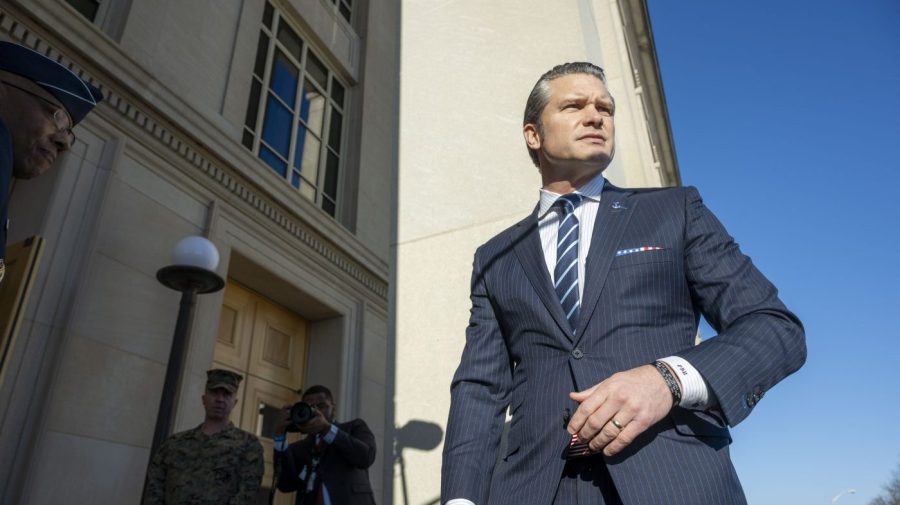
Secretary of Defense Pete Hegseth’s goal to get “woke” civilian professors out of military academies and replace them with military personnel would be a tall order.
Experts note that recruiting problems are top of mind at the Pentagon, casting doubt on pulling more military personnel into the academies, where around 50 percent current of instructors are civilians.
“We need more uniformed members going back into West Point, the Air Force Academy, the Naval Academy as a tour to teach with their wisdom of what they’ve learned in uniform instead of just more civilian professors that came from the same left-wing, woke universities that they left and then try to push that into service academies,” Hegseth said at his confirmation hearing.
Sen. Tommy Tuberville had asked the then-nominee about how he would handle service academies, which the Alabama Republican said had become a “breeding ground for leftist activists and champions of DEI and critical [race] theory.” Tuberville said he knew a young man who had wanted to go to West Point but later turned it down over those issues.
There are five military academies, with three that reside directly under the Department of Defense: West Point, the Naval Academy and the Air Force Academy. The United States Merchant Marine Academy is under the Department of Transportation’s Maritime Administration, while the Coast Guard Academy falls under the Department of Homeland Security.
Hegseth will also have control over the five U.S. war colleges and more than 150 K-12 schools for military families.
“The problem that Hegseth would run into — aside from the academic problem that it’s probably good to have these young cadets exposed to civilian faculty also — but there’s just a practical personnel problem, staffing problem,” said Mark Cancian, a senior adviser with the Center for Strategic and International Studies Defense and Security Department.
The United States Naval Academy told The Hill it has had roughly a 50-50 split between military and civilian instructors since its founding it 1845, when it began with four military teachers and three civilian ones. Currently, it has approximately 600 teaching faculty, 45 percent military instructors and 55 percent civilian ones.
“The fraction of civilian instructors has fluctuated over time, but not significantly,” the academy said.
The Air Force Academy Admissions’ “Academic FAQ” page says the institution has around 70 percent military instructors and 30 percent civilian.
A 2022 West Point document about the “STEM Faculty Experience” said around 27 percent of faculty were civilians.
The Air Force Academy and West Point did not respond to The Hill’s request for comment.
Brad Bowman, senior director of the Center on Military and Political Power at the Foundation for Defense of Democracies and former graduate and instructor at West Point, said the school when he was teaching also had a pretty even split civilian professors and rotating and permanent military instructors.
“It’s just, in my experience, was a wonderful system. And I think any kind of flippant remark that professors, all or most of the civilian professors, are far left or ‘woke,’ I think would be unfair,” Bowman said, adding that he co-taught a course with a civilian professor.
“We were a wonderful team, providing complimentary assets and skills to one another, and we were both better, I think, as a result,” he said.
“You want a diversity within a reasonable range. Of course, you don’t want someone who thinks terrorism is great or loves the Chinese Communist Party or thinks America is horrible, but you know, within reasonable bounds, you do want a diversity of views, and you certainly want a diversity of experiences, and that diversity is not a bad thing or a dirty thing or a liability, it’s an asset,” he added.
The Hill has reached out to the White House and Department of Defense for comment.
The military has said only 23 percent of young people are qualified to serve without a waiver, and the branches have fallen short of recruiting goals for several years, The Associated Press has reported. With lower recruiting goals in 2024, all branches met their marks apart the Navy.
In order to fill military academy positions, officers would have to be pulled from other areas of service, potentially even those in combat units.
“It just doesn’t make sense to pull a lot of officers out of combat units to put them in teaching in the academies. In fact, you might even want to go a little the other way, just because of personnel shortages,” said Cancian.
It could also be a difficult task to find all the service members an academy would want with expertise in the classes needed.
When asked if there could be enough military instructors to cover their classes, the Naval Academy said it would be “inappropriate to speculate.”
“Though there is an almost equal balance of military and civilian professors among the USNA faculty, they are not spread equally across academic departments or courses,” it added.
Cancian said “it’s been a pretty smooth collaboration” as far as he knows.
“The tension in the … particularly in the war colleges, I think, also in the academies, but more so in the war colleges, has been, ‘What is the purpose of this institution? Is it educational?’ In which case, you bring in more civilians,” he said. “’Is it military and to prepare people for a military career?’ In which case, you might lean more heavily on the military, and this tension has gone back and forth over the decades.”
Hegseth has not directly addressed the military/civilian instructor balance since being sworn in, though a memo he sent Pentagon leaders indicates he expects the academies to advance a strongly patriotic agenda.
“The U.S. Service Academies and other defense academic institutions shall teach that America and its founding documents remain the most powerful force for good in human history,” he wrote.











